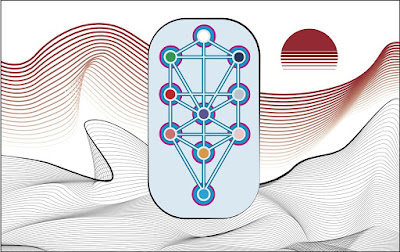
Composed in Middle-Age Spain (c.1100 - c.1400 CE). The Zohar (Splendor or Radiance) is the foundational work in the literature of Jewish mystical thought known as Kabbalah. It is a group of books including commentary on the mystical aspects of the Torah (the five books of Moses) and scriptural interpretations as well as material on mysticism, mythical cosmogony, and mystical psychology. The Zohar contains discussions of the nature of God, the origin and structure of the universe, the nature of souls, redemption, the relationship of Ego to Darkness and "true self" to "The Light of God", and the relationship between the "universal energy" and man. Its scriptural exegesis can be considered an esoteric form of the rabbinic literature known as Midrash, which elaborates on the Torah. The Zohar is mostly written in what has been described as an exalted, eccentric style of Aramaic. The Zohar first appeared in Spain in the 13th century, and was published by a Jewish writer named Moses de Leon. De Leon ascribed the work to R. Shimon bar Yohai. The Zohar spread among the Jews with remarkable swiftness. Scarcely fifty years had passed since its appearance in Spain before it was quoted by many Kabbalists, including the Italian mystical writer Menahem Recanati and by Todros Abulafia. Certain Jewish communities, however, such as the Dar Daim, Andalusian (Western Sefardic or Spanish and Portuguese Jews), and some Italian communities, never accepted it as authentic. Whilst some people believe it is genuinely part of an oral tradition, handed down from Moses to R. Shimon B. Yohai, others continued to oppose this. The noted Kabbalist Isaac of Acco is supposed to have heard directly from the widow of de Leon that her husband proclaimed authorship by Shimon b. Yohai for profit. Joseph ben Todros and his student Jacob both swore an oath that de Leon did not write it. Elijah Delmedigo (c.1458 – c.1493) endeavored to show that the Zohar could not be attributed to Shimon b. Yohai, by a number of arguments. Debates continued right up until the modern era with R. Yahyeh Qafeh attacking what he saw as subversive doctrines found in it. Modern scholarship, led by Gershom Scholem, tends to agree with Isaac of Acco's statements.
ZOHAR - THE BOOK OF SPLENDOR
Basic Readings from the Kabbalah
Edited by Gershom Scholem
ON THE SELECTION FOR THIS TEXT
It would seem to be nothing less than presumptuous to offer any selection from such work as the Zohar, and, recently, it is difficult to focus into a brief book anything like the richness of content, the plenitude of ideas inhering in the original. Indeed, no selection can assume the task of portraying the mystical doctrine of the Zohar. Such a presentation – if at all feasible within the compass of a small volume – would require an apparatus of explanatory notes and comments of no less size than the body of text.
What I have therefore attempted to present in the pages following is a sequence of passages which might be expected to arouse an immediate interest in the reader: by the colourfulness with which the life of the soul is pictured, by the curious poignancy of scriptural exegesis, by the outright paradoxicality of the thoughts asserted.
All the passages selected – some given in a slightly condensed form – have in common their direct appeal not dependent on the interpretation of the numerous technical and symbolical associations in which the texts abound. Some absolutely necessary explanations are provided in the footnotes. On the whole, however, I ventured to assume that the interested reader would himself desire to reflect on the profuse symbols and images as they appear herein. It was in such manner that the Zohar did appeal to wider circles of readers through the ages. It matters little whether this or that symbolic connotation is properly recognized, or not.
With the foregoing in mind, I selected such passages as would throw light on the mystical ideas concerning God, together with the various stages of his manifestation, and on the idea of the soul, its grades and its destiny, as taught by the Zohar. I a number of instances, one passage may find elucidation by another.
Nor did I deem it wise to arrange the volume according to themes and topics. Such an organization does not recommend itself, inasmuch as all the passages selected are broadly interrelated, one being connected and bound up with another. Thus it was found advisable to follow, on the whole, the same sequence in which the pieces appear in the original text of the Zohar.
This small volume will have fulfilled its task if it succeed in conveying to the reader some notion of the power of contemplative fantasy and creative imagery hidden within the seemingly abstruse thinking of the kabbalists.
G.G.S.
CONTENTS
(The Roman numerals and the pagination refer to the standard editions of the Zohar which in turn follow the first edition, Mantua 1558-60. Click on the individual title-links and a new window will open)
GENESIS
- The Beginning, I.15a
- The Universe: Shell and Kernel, I.19b
- The First Light, I.31b
- Creation of Man, I.34a
- Male and Female, I.49b
- Consuming Fire, I.50b
- Departure from Life, I.57b
- The Three Strands of Spirit, I.62a
- Highest Grade of Faith, I.83b
- Midnight, I.92b
- Jacob's Blessing, I.146a
- Greater Than Joseph, I.201b
- The Great Feast, I.217b
- Jacob's Death, I.221b
- A Seal upon Thy Heart, I.244b
EXODUS
- The Ten Sefirot, II.42b
- Out of the Depths, II.63b
- Two Aspects, II.64b
- Sabbath, II.88a
- The Lovers of the Torah, II.94b
- The Destiny of the Soul, II.96b
- Suffering of Innocent Children, II.112b
- The Three Aspects of the Soul, II.141b
- Serve the Lord with Gladness, II.165a
- The Stars, II.171a
- An Allegorical Explanation of Jonah, II.199a
LEVITICUS—NUMBERS—DEUTERONOMY















